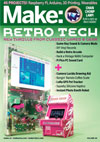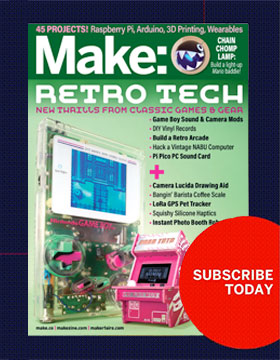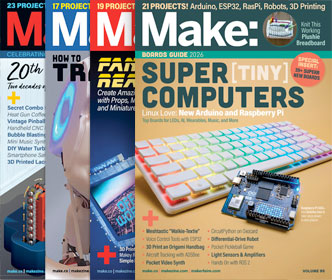
In Atlanta, a civic response coordinated through four area makerspaces is going up against Covid-19 and hopes to beat it. This in another story in Make’s chronicle of Plan C: A Civic Response to Covid-19.
My initial experience of Decatur, GA was arriving at 6:00am on a drizzly Sunday morning in October 2015. Nothing was yet open. I sat outside on a bench and watched the town wake up. I had taken a red-eye flight to Atlanta and caught a cab to Decatur, which is about 6.5 miles east of the city. I was there for Atlanta Maker Faire, which took place in Decatur. The Decatur Makers group was the most active makerspace in the area and they had persuaded the town to let them use public buildings and parking lots for Maker Faire Atlanta, which was originally started at Georgia Tech.
Decatur Makers continues to be a hub for makers in the area, connecting with Atlanta and Georgia Tech. Irm Diorio, the Executive Director of Decatur Makers, said: “One of our members posted to the group – ‘Hey, anyone interested in just getting together to talk about hacking, making PPE? There’s going to be this need.’” It was the start of Atlanta Beats Covid-19 (ABC), which is now a collaboration among four makerspaces in Atlanta and a civic response to fulfill requests for thousands of PPE. The actual work, though, started by “scouring the internet to see ‘what’s out there, what are people asking for?’” said Irm. Through connections to the medical community, some of the members began asking doctors and nurses directly what they specifically needed.
“We jumped into making face shields because that was the quickest to jump into and make,” said Irm. “We were taking what was out there and kind of tweaking it as makers do.” They began producing four different products. “Currently we’re making face shields (various designs/methods), and elastic strain relievers,” said Lew Lefton, a member of Decatur Makers and Assoc. VP of Research Computing at Georgia Techl. The group has partnered with another organization, Sewing Masks for Atlanta, for cloth masks. “We’re also creating intubation enclosures with six being delivered to a local hospital this week and finishing up the prototype for an N95-like respirator mask,” said Lew in late April.
Lew Lefton
I asked Irm about the process of getting feedback from healthcare professionals. “The hospitals were so overwhelmed that it was hard to get a lot of feedback quickly,” said Irm. “So then the conversation became: ‘let’s give you things and you take what works best for you.’ That’s kind of where we started.”
The member who had rallied the group to start making was Lee Whitcher, who is a graduate student in Aerospace at Georgia Tech. Whitcher is originally from England, having done his bachelor’s and master’s at the University of Sheffield. He came to the US in 2013 to do his PhD. And he’s nearly done after many years.
“I work at Georgia Tech as well as doing my PhD and so I just started this job maintaining and upgrading all the teaching labs in aerospace and also some research labs that include the wind tunnels,” said Lee. When Georgia Tech shut down the campus and went to remote instruction, the only people allowed on campus were for essential research. Lee was at home, thinking: “Great, this is an opportunity for me to finish my thesis.” But that didn’t happen.
“I have always styled myself as a nice blend of a ‘doing’ engineer and an academic engineer,” he said. In a crisis, he knew the kind of role he could play. He could actually get stuff out the door. “I sat thinking that this is exactly the use case for what I’ve always sold myself as,” Lee said. “So it would be stupid to not do it.” He jumped in, setting his dissertation off to the side.
Lee worked on the intubation enclosures — clear plastic boxes that fit over the head of a patient and provide holes for a health care professional to insert their hands and do the work of intubating a patient. “Intubation is a simple procedure, at least in theory but it can be difficult to execute amid the gag reflexes, sputters and expectorations of the patient,” writes David Quammen in his 2012 book on zoonotic viruses, Spillover.
The ABC Mask
Lee has also designed a fitted respirator mask that he is calling the ABC Mask. It started with an outer shell and an inner shell that 3D printed pieces, which along with a silicone gasket holds a replaceable filter in place. It has a silicone rubber seal (the white piece in the photo below) that fits against the face.
“The mask is a much more of an engineered product,” he said. “It obviously has to work on so many different people’s faces for a decent amount of time and keep a good seal.” He iterated on the design of the seal by 3D printing a mold tool in PLA for each design iteration. It has a thicker lip fitting against the face. “This piece butts up against your face and gives you a much larger surface area with which to generate a seal so it can conform to a thin face or a chubby face like mine,” said Lee with a self-deprecating smile.
“It seals on every person we’ve tried it on, even a person with a beard,” he said. “But that part took a lot of time to get right.”
From 3D Printing to Casting
The mask and the face shields were initially 3D printed but now, Lee said, “all parts are molded and cast.” He added:
3D printing was used in two stages: first to prototype the geometry of both the shells and the seal (unprocessed PLA), and then to produce master patterns from which we made silicone molds (some ABS with acetone smoothing and others SLA and polyjet).

.
“I actually made a silicone mold of the plastic molds, which I then use to cast the final plastic molds,” explained Lee. “It’s a mind trip.”
The ABC Face Shield
The first face shields made by the group used a mixture of the existing designs for shields (Wisconsin, the New York, the Prusa, and the Budmen).
Since then, they have designed the ABC Face Shield based on the Prusa frame. This shield design is optimized for molding/casting and includes a sealed browguard. The design was a joint effort between Lee and Skyler Holobach, another member. “The frame mold looks so pretty because we optimized the master pattern and mold box to minimize silicone usage,” said Lee.

Skyler has also experimented with adding pigments to create more colorful versions..
The group has over 20 sets of molds with plans to make hundreds more. They will take these mold tools to people’s homes and provide documentation on how to pour them. Skyler has five sets of molds and her personal best is 170 frames in a single day.
Lee said that it was easy to understand that a tangible thing, something like a mask that you hold in your hand, was the result of innovation. But Lee mentioned the work of Milt Walker. “He put together an awesome software system for tracking requests and matching requests with production. Logistics, that stuff is not easy to do” said Lee.
A Distributed Manufacturing Company
Milt Walker is the Executive Director of the Southeast Makers Alliance that puts on Maker Faire Atlanta. He is a computer engineer who formerly worked at Intel. He told me that the first thing Irm and he talked about when they began helping to pull this together was the idea of building this distributed manufacturing company,” said Milt. “How do we make things work? How do we synchronize things? And how do we pull this off?”
“We started on Google groups, which quickly became overwhelming on all of us communicating,” said Milt. “I know Lee was probably the first one to say, get us off of Google groups.” There is a pattern of small groups working well in the beginning and then getting overwhelmed as more people show up and more work needs to be done. It is a transition from a loosely organized group to a managed one. Milt recognized a need for a project management system and settled on Trello.
They had to be able to take requests, and then go through the pipeline of building out and then delivering a product. “Obviously that sounds easy,” said Milt “but then you throw in the complexity of having people making stuff at home and in makerspaces and having it all distributed…”
“If you look at where we are now compared to where we were two weeks ago, people are saying ‘okay, I get it.’ We know what we gotta do. We’re doing it. We’re getting stuff out,” said Milt. “We went from making things on the order of a couple of hundred a week to almost the last two weeks, we’ve put out a thousand things in a week.”
ABC has been delivering PPE to all the major medical facilities in the area, but there is also a need elsewhere such as outpatient doctor’s offices. “We’ve got a spike recently,’ said Milt. “Alot of the dentist’s offices are asking for stuff because before all this stuff happened, they gave all their stuff to hospitals. So they don’t have PPE.”
Coordinating Among Four Makerspaces
Irm was familiar with the Chicago Shield story in which a number of separate nodes, each doing the same work, was their version of distributed manufacturing. “Our is structured a little different,” she said. “We have our makerspaces all working together but It’s not like each one is developing and creating and delivering its own set. She described what the other makerspaces are doing:
William Strika: Roswell FireLabs which is our central point/quality control for all 3D printed face shields as well as cutting elastic strain relievers.
Tanju Bayramoglu (ED) and Randy Farmer: Marietta Maker Station which is CNCing plastic shields, cutting gown patterns, and assembling both Wisconsin and NY face shields. Also, Tanju was instrumental in facilitating the Southeast receiving many large rolls of 30 mil PET plastic for our face shields, not just for GA but for other southern states.
Josh Reddick and Dawn Puckett: Geekspace Gwinnett which is lasering plastic shields and cutting and making cloth masks.
“So materials going from makerspace to makerspace and then going out and being delivered as well,” she added. Each space is following social distancing guidelines and they are taking the temperatures of anyone who shows up to work. Quality control of items was a big reason for setting up each makerspace in a specific role. “We just want to make sure that what we’re sending out is the best that we can provide,” said Irm.
Young 3D Printing Entrepreneurs
Because Decatur Makers is an all-ages makerspace that supports youth in education, innovation and entrepreneurship through making, Irm was happy to remark on what she’s noticed in various forms from the younger generation. “We receive regular drop-offs of 3D printed shield bands from an 11-year old who has ‘started his own 3D printing business’ (see photo below of the flyers he attaches to his drop-offs). A team of high school youth pivoted their food delivery startup to help us deliver PPE, a couple of college students started one of our partner organizations, Atlanta Face Shields, raising over $21K, and a couple of young female professionals, another partner, started Atlanta Shield Makers and received local TV coverage.”
Medical teams grateful for Atlanta Shield Makers
“Every Single Day is Crazy”
“ABC didn’t exist five weeks ago and the way that it has managed to not only grow, but sustain and manage its growth is already something impressive,” said Lew Lefton.
“I look back after five weeks, said Lee Whitcher, “and I think what would life be like now if this hadn’t happened? I would have regretted not doing it. It is still crazy. Every single day is crazy. I still wouldn’t change anything we’ve done.” I asked Lee if any of the work he’d done could be applied to his dissertation. He had let his thesis advisor know about his real-world project and he told Lee to put it in an appendix and on his C.V.
Irm Diorio provided some figures around ABC’s efforts:
- Delivered over 10K PPE products. This includes face shields, elastic strain relievers, medical gowns, intubation enclosures, some smaller miscellaneous items
- Donations and sponsorships are over $42K which includes $10K from the Blank Family Foundation. Our partners have raised over $21K also
- There are over $60K through in-kind donations/services and growing
Georgia is one of those states that is opening up faster than others. It creates an even bigger demand for PPE and growing concern from the community. Milt told a story about LA Fitness, a health club that was planning to re-open on a Friday in late April. “So many people responded to LA Fitness by shutting down their memberships that they walked back on opening up. They sent a letter saying that, Hey, we’re going to keep things closed and so forth and so on.”
Links:
Grabcad: Design files for Intubation box, ABC Face Shield and ABC Mask
Images: Courtesy Atlanta Beats Covid and Lee Whitcher
ADVERTISEMENT
Join Make: Community Today


























